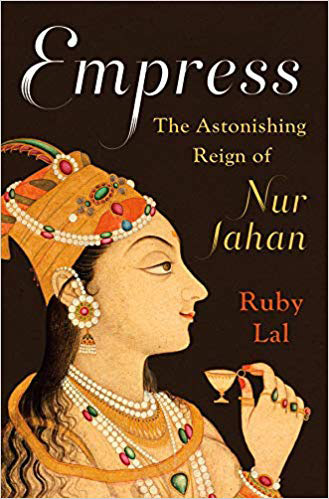Natural-born leader
Never underestimate a seventeenth-century Muslim queen with dead aim, a big attitude, and the will to rule

Don't let the image of Nur Jahan on the cover of her latest biography fool you. On it, she delicately holds a tiny tea cup— perhaps, one might think, an all-too-common way to pass the time for a queen serving alongside a more-powerful husband. But gender boxes don't fit Nur, as we learn from the first pages of Ruby Lal's Empress: The Astonishing Reign of Nur Jahan.
Lal, professor of South Asian studies, is an expert in feminist history and theory. The way she sets the stage for Nur is part and parcel of why audiences for Empress have far exceeded what might be expected for a biography of a seventeenth-century Muslim queen.
Nur was the twentieth wife of Jahangir, the fourth of the Mughal emperors of India-- a Muslim dynasty established by invasion in the sixteenth century. Though a late addition to the ranks, Nur, by all accounts, was Jahangir's favorite.
Says Lal, "Beautiful and accomplished, Nur Jahan was the daughter of nobles who'd fled persecution in Persia. She was also the widow of a court official implicated in the plot against Jahangir, but that didn't stop the emperor from falling hard for her. She was thirty-four when they married, nearly middle-aged in the Mughal world."
Not to mention an expert markswoman. Lal describes a royal trip to the people of Mathura, who were anxious for the arrival of the emperor, having been assailed by an attacking tiger for months. Jahangir could not intervene, having promised Allah when he turned fifty that he would not injure any living being. That vow did not constrain his queen, however, and as Lal describes it, "The tiger emerged from the trees. Nur lifted her musket, aimed between the animal's eyes, and pulled the trigger. Despite the swaying of her elephant, one shot was enough; the tiger fell to the ground, killed instantly."
And that is just the opening entry in a list of extraordinary attributes, for Nur served as co-sovereign— a position never held by a woman. For fifteen years, until the time of her husband's death. Nur ruled alongside him, issuing her own imperial orders and, says Lal, "successfully navigating the labyrinth of feudal courtly politics and the male-centered culture of the Mughal world."
Eventually, Jahangir was considered by a contemporary historian as king "only in name." A generation earlier, Jahangir's father had ordered all royal women — wives, daughters, and concubines — to be hidden behind harem walls. Nur, however, broke that mold by virtue of being "on view in the most male and public of places. A new kind of power was on display."

Lal first heard about Nur from her mother, who, she notes, "had a bagful of wondrous tales for my two younger sisters and me." She describes her father as often eavesdropping on the storytelling from behind a newspaper. But hiding didn't spare him. Lal remembers turning to him and saying, "I am Nur Jahan. You are Jahangir." Despite the comic mileage that bold statement earned in family lore, it rang true: Lal became a feminist historian.
The author of Domesticity and Power in the Early Mughal World and Coming of Age in Nineteenth-Century India: The Girl-Child and the Art of Playfulness, Lal was a natural for Nur's biography. In the process, she discovered that although South Asians know many legends about Nur and recite them with pride, "the emphasis on her romance with Jahangir truncates her biography in a way that diminishes her. In the popular imagination, Nur's story seems to stop at the very moment when her life's best work began."
Lal turns that tide by examining Nur's accomplishments— among them, leading imperial troops to rescue her husband when he was taken prisoner by a rebellious nobleman in 1626. Says Lal, "It would be another 350 years, when Indira Gandhi became India's first female prime minister, before another woman ascended to such heights in Indian statecraft."


